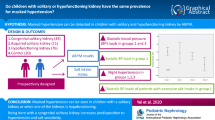Abstract
Multicystic dysplastic kidney (MCDK) is one of the most common congenital renal anomalies. Arterial hypertension is a potential complication of MCDK. Blood pressure (BP) has so far been measured only casually and the frequency of hypertension has been estimated to be between 0%–8%. Ambulatory blood pressure monitoring (ABPM) provides more precise information on BP than the casual BP measurement. The aim of this study was to investigate the BP profile in children with MCDK using ABPM. A group of 25 children (16 girls), with a mean age of 7.8 years (range 3.8–17.7 years) were investigated. ABPM was performed using the oscillometric SpaceLabs 90207 device. Hypertension was defined as mean systolic and/or diastolic BP during the day and/or in the night exceeding 95th percentile for ABPM. Five (20%) children showed hypertension, two of them had combined daytime and night-time hypertension and three had isolated nocturnal hypertension, although daytime BP was between the 90th–95th percentile in two of them. Children with ultrasonographical and/or laboratory signs of contralateral kidney abnormalities showed a higher incidence of hypertension than those without abnormalities (two of four versus 3 of 21). The mean night-time systolic and diastolic BP of children with MCDK was significantly higher than in healthy children (+0.50 and +0.54 SDS, respectively, P=0.012 and 0.03, respectively). Three of the hypertensive children were already nephrectomised. All five hypertensive children showed ultrasonographical and/or laboratory signs of contralateral kidney abnormalities. Hypertensive children had significantly higher microalbuminuria than normotensive children (6.9 ± 3.2 mg/mmol creatinine versus 1.8 ± 0.7, P=0.03). The nocturnal BP fall (dip) was attenuated in five children, only one of whom was hypertensive.
Conclusion Arterial hypertension in children with multicystic dysplastic kidney is seen more often if based on ambulatory blood pressure monitoring than on casual blood pressure recordings. The main risk factor for developing hypertension is contralateral kidney damage. Ambulatory blood pressure monitoring should be performed in children with multicystic dysplastic kidney, especially in those with contralateral kidney abnormalities.
Similar content being viewed by others
Author information
Authors and Affiliations
Additional information
Received: 20 July 1999 and in revised form: 27 November 1999, 24 March 2000, 3 May 2000 Accepted: 3 May 2000
Rights and permissions
About this article
Cite this article
Seeman, T., John, U., Bláhová, K. et al. Ambulatory blood pressure monitoring in children with unilateral multicystic dysplastic kidney. Eur J Pediatr 160, 78–83 (2001). https://doi.org/10.1007/s004310000579
Issue Date:
DOI: https://doi.org/10.1007/s004310000579




